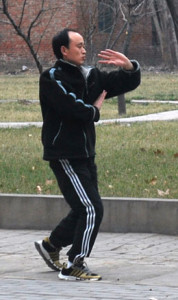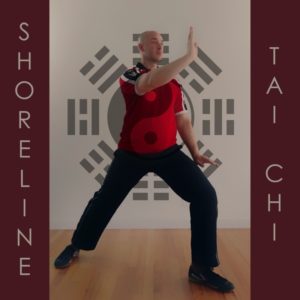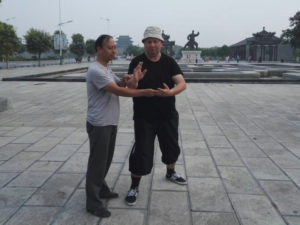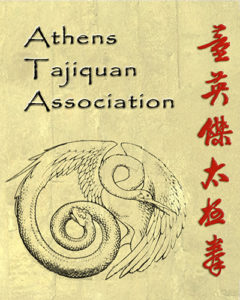Slanted FlyingJournal of Tai Chi Chuan
Training
Why Is Fajin The Secret Weapon Of Taijiquan?
The saying goes: “Man derives his Qì from Heaven and Earth.”
The saying is suggesting that Human Qì comes from Heavenly Qì (the air we breathe) and Earthly Qì (the food we eat).
Furthermore, the fundamental concept behind the practice of Chinese medicine is the idea that disease can be traced back to a problem with the proper flow of Qì. In the West, we are taught that disease is caused by infection (a virus or bacteria), but in TCM, we believe the virus or bacteria was able to get a foothold inside a sick person’s body because that sick person had a problem with their Qì before they encountered the infection.
Problems with the flow of Qì in the body can also account for the pain of physical injury.
If it is not severe, injury merely causes a stagnation of Qì flow, but if it is serious trauma, the Qì and blood both become static leading to greater pain and more problems at the injury site.
 When someone uses Diǎnxué and strikes a cavity, the effect on the body’s Qì and blood is no different than hitting any other part of the human body. The Qì and blood stagnate leading to pain, swelling, and a lack of free flow of energy in that area.
When someone uses Diǎnxué and strikes a cavity, the effect on the body’s Qì and blood is no different than hitting any other part of the human body. The Qì and blood stagnate leading to pain, swelling, and a lack of free flow of energy in that area.
The difference is the location.
If an acupuncture point can be used to help a certain problem, causing the Qì to stagnate at that point can reverse those effects, causing the very problem an acupuncturist might use that point to treat.
If it’s that simple, then why has Diǎnxué been surrounded by mysticism for so long?
The study of Diǎnxué didn’t stop with the simple act of blocking the Qì at a specific point. In Chinese Medicine there is a concept known as “Chronotherapeutics.” According to ancient texts on acupuncture, Qì takes a little less than 30 minutes to circulate through the meridians of the body, and as it circulates during the day certain meridians, and even specific points will be replete with Qì while other meridians and points will be more depleted.
Specific points can be targeted during specific times of the day, shutting down meridians and leading to illness and death in the future, turning an explosive Fājìn strike into a time-bomb of sorts.
However, this level of study is tedious and not very effective for the average martial artist which is one reason teachers who know this don’t bother teaching it. Furthermore, the only point of learning this is to maim or kill—sometime in the future—which is the very definition of premeditated murder.
Not something a martial artist with good character would ever employ.
This doesn’t mean that Diǎnxué cannot be an effective technique, however.
It’s use has to be altered, slightly, however.
Instead of striking a series of points that will lead to death, strike a single point that will disable the opponent temporarily, allowing the fighter to end the fight quickly or escape—that is, after all, the point of self-defense, right?
For example, if an acupuncture point is good for the eyes, a martial artist can strike that point with Fājìn, causing local Qì and Blood Stasis. The person hit will have an immediate problem seeing. The advantage of this is that some of these points are even on the back, arms, and legs. A martial artist can’t always reach his opponent’s eyes, but often times, they will have access to an area that offers a good point for striking. Other points that help with vomiting, diarrhea, wake a patient from sudden fainting, or clear the mind can be targeted leading someone to puke, have an accident, pass out, or become confused—all of which can potentially end a fight. In this way, a Tàijíquán practitioner can employ Diǎnxué defensively rather than for criminal purposes.
In spite of the fact that he often has as many detractors as supporters, Earle Montaigue has done a lot of valid research into Diǎnxué and has written several books on the subject (he tends to call it Dim Mak instead of Diǎnxué). If you wish to add some of these striking points into your Tàijíquán training, his books are a good place to start. I also recommend using a training dummy as this kind of training is ill suited for partner work! You and your partner would be spending a lot of time at an acupuncturist’s office, fixing all the stuff you’ve caused to go wrong otherwise.
Even if you don’t wish to take the time to memorize and practice striking cavities, it is important to remember that Fājìn training turns the theory of tī dǎ shuāi ná (踢打摔拿), which we discussed in my previous article, on its ear! Suddenly a Tàijíquán practitioner’s strikes are effective, even at close range. This kind of thing will take a wrestler who is used to moving in close without fear of being hit, by complete surprise!
So for that reason, and because it suddenly opens the door for Diǎnxué to be used effectively, Fājìn is the secret weapon of Tàijíquán!













